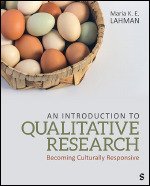Writing Across Qualitative Research
by Maria Lahman, Ph.D. and Tyler Kincaid Ph.D., panelists for the How to Do Research and Get Published webinar, How to write a paper: Qualitative methodology.
Dr. Lahman is the author of An Introduction to Qualitative Research: Becoming Culturally Responsive (2024), Writing and Representing Qualitative Research (2021), and Ethics in Social Science Research: Becoming Culturally Responsive (2017). Use the code COMMUNIT24 for 25% off through December 31, 2024.
Writing and publishing qualitative research
“Most writers have totally unrealistic concepts of how publishing works”— is an assessment attributed to the American poet and author Jim Harrison. We, Maria and Tyler, have found our personal writing experiences to echo Harrison’s sentiments. As we first moved from course-assigned research, dissertations, and grant work to the publication process, we entered the stark reality that we did not clearly know how to proceed. A point rarely addressed is, that even when a researcher may be seen as an established scholar, publishing across a career has its highs and lows. The question, then, that we strive to answer becomes—how might qualitative researchers successfully move into the publication process and maintain impactful productivity?
Making the writing for publication process transparent is the primary way to help researchers have realistic expectations and be able to publish and persevere. At the upcoming webinar, How to Write a Paper: Qualitative Methodology, we discussed the following topics and, in this blog post specifically, highlight—writing across the research process.
● How can researchers best use storied data in qualitative research writing?
● How should you deal with sensitive, controversial, or inflammatory messages in the data?
● What ethical guidelines do qualitative research writers need to follow?
● Writing across the qualitative research process.
● Top writing tips.
Think about writing throughout the research process!
Ideally, qualitative research writing should be integrated across the research process from before the research idea has been fully formed through the promotion of publication. A main way qualitative researchers integrate writing across the research process is through a researcher reflexivity journal (Brown, 2021). A research journal is a safe space, that may enhance who we are as ethical beings (Lahman, 2018), to write about possible ideas for research and the first research steps—a place to trace our wonders and wanderings.
Tyler’s dissertation journal, for instance, took the form of voice-to-text dictations as he drove or moved around the research field. These journal entries had a sense of immediacy and raw vulnerability that extended Tyler and the readers' understanding of the fieldwork process (Kincaid, 2019). Tyler’s researcher reflexivity notes were transcribed in the same way research participant interviews are. This allowed his journal to convey a sense of real-time as the entries occurred during fieldwork or while leaving the field. Tyler first developed the idea of a spoken researcher reflexivity journal while researching punk rock bands. For settings that include extensive researcher mobility—driving, walking, and just being there—dictating into a voice-to-text app or recorder is ideal. We challenge qualitative researchers to identify and capture moments of raw reflexivity in order to integrate them into research accounts and provide increased transparency to the research process.. An example from, Tyler’s research follows.
The first time Texas (person experiencing homelessness) started crying in our interview, my first interview, I was like “What the hell is happening”?! I’m not ready for this. We’re supposed to be talking about sampling considerations and best practices. . . . What is this all of a sudden?
I’m sitting in a strange office inside of a homeless shelter I just walked into for the first time a couple of hours ago, and now Texas is in full-blown crying mode about how they became homeless! I didn’t even ask that question. We were talking about pseudonyms two seconds ago. How am I supposed to handle this now? Are there tissues in this office? Should I say something? Should I ignore it? Should I respond with something generic like “I'm sorry you're crying, here's a Kleenex”?! Already, I’ve separated myself from the crying person in front of me. . . . How in the hell does this answer my research question!? Ok, never mind, just shut up and listen. . . .
Start or join a writing group
Find support and motivation in a writing group!
Consider forming a writing group (Durst, 1992) to help keep reflexive research journaling and writing on your mind and calendar. Writing groups are not just for students and may help carry researchers across the ups and downs of careers. Writing groups are a safe space for researchers to share versions of their current writing project to receive critique, goals, frustration, and successes.
A writing group could be broadly conceived of in order for it to also function as a “critical friends group” (Noor, 2021; Swaminathan, & Mulvihill, 2017), a qualitative research trustworthiness enhancement strategy, that fits well with any research but critical research in particular. In Maria’s[3] text, Introduction to Qualitative Research: Becoming Culturally Responsive (2024), she wrote, “This carefully chosen friend works with the researcher within a nonhierarchical relationship to support deeper, more multifaceted research and understandings. A critical friend poses questions in a supportive manner to unearth deeper layers of understanding”. This may include reciprocal listening, sharing, and facilitating . . . help[ing] each other maintain deep integrity by asking supportive questions that challenge assumptions, help the researcher re-examine their positionality throughout the research project, and gently refocus the researcher . . . to the next . . . questions that . . . need to be asked . . .” (Swaminathan, & Mulvihill, 2017, p. 70). (See this related post by Dr. Lahman.)
You can do this!
A research reflexivity journal, writing group, and critical friends group will help researchers navigate the process of moving from a newly sparked research idea to disseminating research in generative ways.
Reference and Resources
Brown, N. (2021). Making the most of your research journal. Bristol: Policy Press.
Durst, R. K. (1992). A writer’s community: How teachers can form writing groups. In K. L. Dahl (Ed.), Teacher as writer: Entering the professional conversation (pp. 261–271). National Council of Teachers of English.
Kincaid, T. W. (2019). Methodological considerations for researching hidden populations with an emphasis on homeless research sampling methods (Publication No. 27669684) [Doctoral dissertation, University of Northern Colorado]. ProQuest Dissertations and Theses Global.
Lahman, M. K. E. (2018). Ethics in social science research: Becoming culturally responsive. Sage.
Lahman, M. K. E. (2022). Writing qualitative research. Sage.
Lahman, M. K. E. (2024). An introduction to qualitative research: Becoming culturally responsive. Sage.
Noor, M. S. A. M., & Shafee, A. (2021). The role of critical friends in action research: A
framework for design and implementation. Practitioner Research, 3, 1-33.
Swaminathan, R., & Mulvihill, T. M. (2017). Critical approaches to questions in qualitative research. Routledge.
This blog post draws on and has been updated in part from Lahman, 2022, 2024.



















Maria Lahman offers tips to help you hone your academic writing